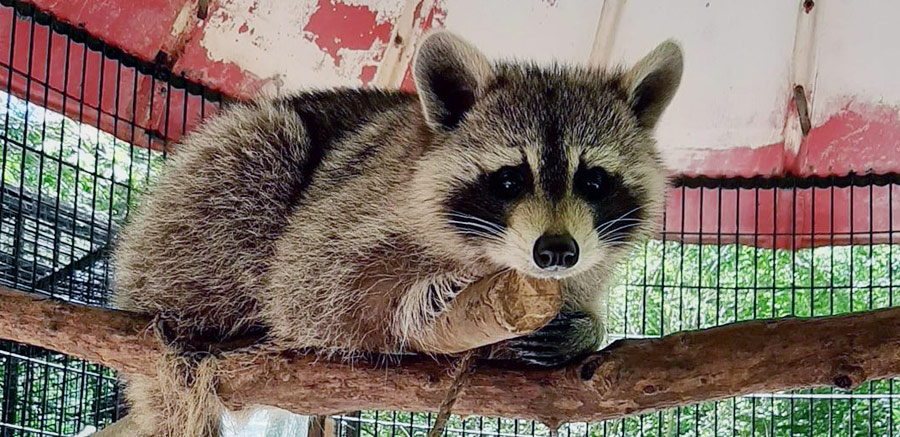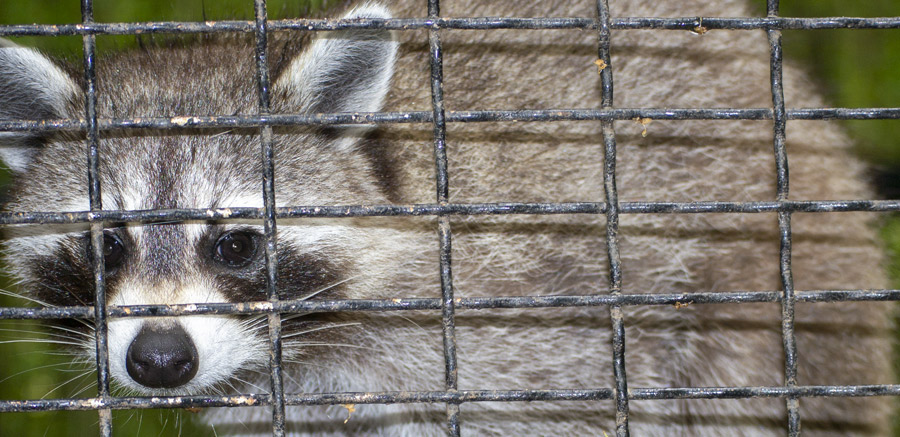
RACCOONS
While adorable, they are unfortunately considered the primary carriers of the rabies virus.
PROFILE
Toes is our only female raccoon and she came to us from a rehabber in Valdosta, GA. Toes was deemed non-releasable because she is imprinted on humans, which means that if she were released into the wild she would most likely approach people for food and this is frowned upon. Toes was deemed non-releasable by a rehabber in Valdosta. She is the only female of our “gaze” and definitely the smartest. She is one of the darkest raccoons and her eyes are the closest together. She is usually seen following close behind the babies, but not quite as active (unless the keepers are around). When the keepers feed the raccoons, they separate the food into 4 bowls and place them on either side of their enclosure, Toes is the first to figure out the bowls on the other side so she doesn’t have to share her food like the others.
Meeko is one of the two babies brought to us by Georgia DNR. He is the darkest of the three boys and the cuddliest. If you look at his tail, he has a “bullseye” on the tip of it. Meeko is the first to wander off from the other two babies and do his own thing.
Rocket is one of the two babies brought to us by Georgia DNR. He is the troublemaker of our “gaze” and usually starts the raccoon “fight club” (where the 2 boys wrestle each other). Rocket is usually seen hanging out with Toes.
OVERVIEW
CONSERVATION STATUS
Least Concern
AVERAGE SIZE
Compared to a 6′ Man
AVERAGE WEIGHT
14 – 23 lbs
AVERAGE LIFESPAN
2 – 3 Years
DIET
Omnivore
REGIONS
North & Central America
Common from Canada to Panama, raccoons have been introduced in Japan, Germany and several other European countries. Raccoons rely on vertical structures to climb and hide from danger. They prefer tree hollows and rock crevices to create dens. They will also use abandoned burrows or safe spaces beneath trees.
APPEARANCE
Racoons vary greatly in size depending on their habitat. Those in warm climates, like Florida, tend to be smaller. Their black mask is easily their most recognizable physical trait. It does more than give them their cute appearance as little thieves, though. Much like the black stripes athletes use under their eyes, the black fur reduces glare providing better night vision for the raccoons. They have long, fluffy ringed tails. They are low to the ground as they have short legs and typically move about on all fours but are also comfortable standing erect on their hind legs.


CHARACTERISTICS
Raccoons can run up to 15 mph and can fall 35 to 40 feet without injury. They are considered the primary carriers of the rabies virus. Raccoons gather sensory data from their hands. Their fingers each have four to five times more mechanoreceptor cells than are found in most mammals. This sense of touch is heightened further when their paws are wet.
Raccoons will eat a variety of plants, invertebrates and vertebrates. Typically they prefer fruits, nuts, acorns, eggs and fish. They have been known to break into chicken coups with even the most intricate locks and fencing. Raccoons will increase food consumption through the fall and while they do not hibernate fully, their activity levels are greatly decreased and they rely on fat stores while not hunting and foraging.
Baby raccoons are called kits or cubs and are usually born in the early summer. Females have one to seven offspring after a gestation period of 60 to 73 days. As a group, a mother and her baby raccoons are called a nursery. At about a year of age, the young will become independent.


